当前位置:
X-MOL 学术
›
Nutr. Diabetes
›
论文详情
Our official English website, www.x-mol.net, welcomes your
feedback! (Note: you will need to create a separate account there.)
Assessment of vitamin D status and parathyroid hormone during a combined intervention for the treatment of childhood obesity.
Nutrition & Diabetes ( IF 4.6 ) Pub Date : 2019-06-04 , DOI: 10.1038/s41387-019-0083-z Teodoro Durá-Travé 1, 2, 3 , Fidel Gallinas-Victoriano 2 , María Jesús Chueca-Guindulain 2, 3 , Sara Berrade-Zubiri 2, 3 , María Urretavizcaya-Martinez 2 , Lotfi Ahmed-Mohamed 2
Nutrition & Diabetes ( IF 4.6 ) Pub Date : 2019-06-04 , DOI: 10.1038/s41387-019-0083-z Teodoro Durá-Travé 1, 2, 3 , Fidel Gallinas-Victoriano 2 , María Jesús Chueca-Guindulain 2, 3 , Sara Berrade-Zubiri 2, 3 , María Urretavizcaya-Martinez 2 , Lotfi Ahmed-Mohamed 2
Affiliation

|
BACKGROUND
Obesity is associated with vitamin D deficiency. The aim of this work is to analyze the changes in vitamin D status and PTH levels in a group of children with obesity receiving combined intervention program in order to get BMI status reduction.
METHODS
Longitudinal study in 119 children with obesity, aged 9.1-13.9 years, included in a 1-year combined dietary-behavioral-physical activity intervention. Anthropometric measurements (weight, height, BMI and fat mass index) were registered every 3 months and blood testing (calcium, phosphorous, 25(OH)D and PTH) were collected at the beginning and after 12 months of follow-up. A control group was recruited (300 healthy children, aged 8.1-13.9 years). The criteria of the US Endocrine Society were used for the definition of hypovitaminosis D.
RESULTS
Vitamin D deficiency was significantly higher in obesity group (31.1 vs. 14%). There was negative correlation between 25(OH)D and fat mass index (r = -0.361, p = 0.001). Patients with BMI reduction throughout combined intervention were 52 (43.7%). There was a significant increase in the prevalence of hypovitaminosis D in patients without BMI reduction at the end of follow-up, but in those patients with BMI reduction there was no changes of vitamin D status.
CONCLUSIONS
Obesity increases the prevalence of suboptimal vitamin D status, and a BMI status reduction in children with obesity may be required to at least stabilize vitamin D status.
中文翻译:

在治疗儿童肥胖的联合干预期间评估维生素 D 状态和甲状旁腺激素。
背景技术肥胖与维生素D缺乏有关。这项工作的目的是分析一组接受联合干预计划的肥胖儿童的维生素 D 状态和 PTH 水平的变化,以降低 BMI 状态。方法 对 119 名年龄 9.1-13.9 岁的肥胖儿童进行纵向研究,纳入为期 1 年的饮食-行为-体力活动综合干预措施。每 3 个月记录一次人体测量数据(体重、身高、BMI 和脂肪质量指数),并在随访开始时和 12 个月的随访后收集血液检测(钙、磷、25(OH)D 和 PTH)。招募对照组(300 名健康儿童,年龄 8.1-13.9 岁)。采用美国内分泌学会的标准来定义维生素 D 缺乏症。 结果 肥胖组维生素 D 缺乏率显着较高(31.1% vs. 14%)。 25(OH)D 与脂肪质量指数呈负相关(r = -0.361,p = 0.001)。在联合干预期间体重指数降低的患者有 52 名 (43.7%)。随访结束时BMI未降低的患者维生素D缺乏症的患病率显着增加,但BMI降低的患者维生素D状态没有变化。结论 肥胖会增加维生素 D 状态不佳的发生率,并且可能需要降低肥胖儿童的 BMI 状态才能至少稳定维生素 D 状态。
更新日期:2019-06-04
中文翻译:

在治疗儿童肥胖的联合干预期间评估维生素 D 状态和甲状旁腺激素。
背景技术肥胖与维生素D缺乏有关。这项工作的目的是分析一组接受联合干预计划的肥胖儿童的维生素 D 状态和 PTH 水平的变化,以降低 BMI 状态。方法 对 119 名年龄 9.1-13.9 岁的肥胖儿童进行纵向研究,纳入为期 1 年的饮食-行为-体力活动综合干预措施。每 3 个月记录一次人体测量数据(体重、身高、BMI 和脂肪质量指数),并在随访开始时和 12 个月的随访后收集血液检测(钙、磷、25(OH)D 和 PTH)。招募对照组(300 名健康儿童,年龄 8.1-13.9 岁)。采用美国内分泌学会的标准来定义维生素 D 缺乏症。 结果 肥胖组维生素 D 缺乏率显着较高(31.1% vs. 14%)。 25(OH)D 与脂肪质量指数呈负相关(r = -0.361,p = 0.001)。在联合干预期间体重指数降低的患者有 52 名 (43.7%)。随访结束时BMI未降低的患者维生素D缺乏症的患病率显着增加,但BMI降低的患者维生素D状态没有变化。结论 肥胖会增加维生素 D 状态不佳的发生率,并且可能需要降低肥胖儿童的 BMI 状态才能至少稳定维生素 D 状态。











































 京公网安备 11010802027423号
京公网安备 11010802027423号